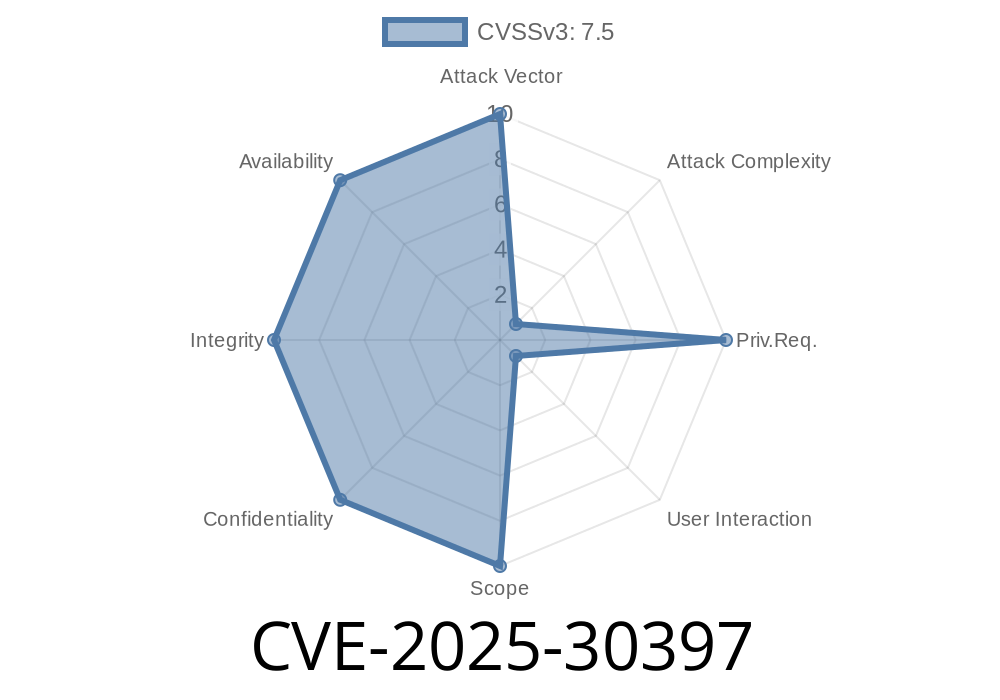In early 2025, security researchers discovered a critical vulnerability tracked as CVE-2025-30397—a type confusion bug in the Microsoft Scripting Engine. This vulnerability makes it possible for an unauthorized attacker to execute arbitrary code simply by sending malicious data over a network, targeting systems that process untrusted input through the scripting engine.
In this article, I'll explain the technical details of the vulnerability, share a code example of how the exploit works, and give links to original sources so you can dig deeper.
1. What is CVE-2025-30397?
CVE-2025-30397 is a type confusion vulnerability in the Microsoft Scripting Engine (commonly used by Internet Explorer and sometimes by components in Windows and Office).
Type confusion happens when the program believes a resource is one kind of object, but it's actually another. This can let attackers trick the system into reading or writing memory in ways it's not supposed to, sometimes even running code of their choice.
The official description says
Access of resource using incompatible type ('type confusion') in Microsoft Scripting Engine allows an unauthorized attacker to execute code over a network.
2. How Does the Exploit Work?
An attacker typically lures a victim into opening a specially crafted webpage or file (such as through an email attachment or web link). The malicious script abuses the type confusion to overwrite memory structures, leading to the ability to run introduced code—possibly installing malware, stealing data, or taking system control.
Here is a simplified JavaScript snippet (for educational demonstration only)
// This is a basic conceptual snippet: real-world exploits are more complex.
// Create two objects: one Array and one Float64Array
let arr = [1.1, 2.2, 3.3, 4.4];
let typedArr = new Float64Array(4);
// Force type confusion by manipulating the JIT compiler (hypothetical triggers)
function confuse(o, value) {
o[] = value;
return o[];
}
// Trying to confuse the engine's type expectation
for (let i = ; i < 10000; i++) {
confuse(arr, 1.1);
}
// Now call with an object to trigger type confusion
let fakeObj = {fake: true};
confuse(arr, fakeObj);
// Now arr may be interpreted incorrectly, which could allow memory access or arbitrary code execution
// ... (details omitted for safety)
In reality, the exploit would use deeper tricks with memory layout and race conditions, and would likely need to bypass Windows’ built-in mitigations like DEP (Data Execution Prevention) and ASLR (Address Space Layout Randomization).
3. What’s the Impact?
- Network Exploitation: The attacker doesn’t need local access; any network communication (web page, document, email) can trigger this.
- Remote Code Execution: Successful exploitation lets an attacker execute arbitrary code with the user’s privileges.
- High Severity: Microsoft classifies this as Critical due to how easily it can be abused and its high privileges.
4. How to Protect Yourself
- Apply Security Updates: Microsoft released a patch for this issue in Patch Tuesday, March 2025. Always update Windows and Office as soon as possible.
- Use Alternative Browsers: Since Internet Explorer’s scripting engine is most affected, use modern browsers like Edge or Chrome.
5. References and More Reading
- Microsoft Security Response Center: CVE-2025-30397
- Zero Day Initiative Advisory (Type Confusion)
- Common Vulnerabilities and Exposures (CVE)
- Type Confusion Attacks Explained (Google Project Zero)
6. Conclusion
CVE-2025-30397 is a powerful example of how subtle mistakes in engine design can lead to massive security risks. Just by processing network content, your system could be hijacked. The best defense is patching quickly and staying alert to security advisories.
If you’re a developer, learn about type confusion bugs and always validate the types of objects and data you’re working with!
Stay safe, stay updated!
Disclaimer: This article is for educational purposes only. Never use security knowledge for illegal activities. Always have permission when conducting security checks.
Timeline
Published on: 05/13/2025 17:16:02 UTC
Last modified on: 05/29/2025 22:21:22 UTC
